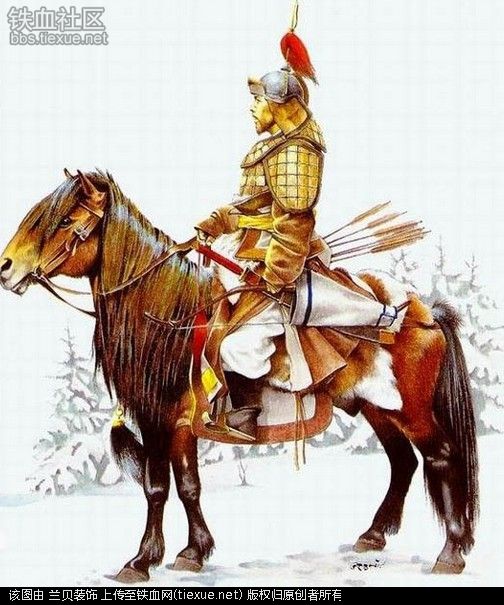Nomadic horsemen from the Asian steppe, the Mongols established one of the world’s largest ever land empires in the 13th century. After the traditionally warring steppe tribes united under the leadership of Genghis Khan, they launched campaigns of conquest westward into the Middle East and Europe, and eastward to China’s Pacific coast. The armies of the settled civilizations of Eurasia were overwhelmed time and again by the speed of movement, aggression, and fighting skills of the all-conquering Mongols.
Before the rise of Temujin, later known as Genghis Khan, the Mongols were merely one among many Turkic tribes living in the tough environment of the steppe north of the Gobi desert. These tent-dwelling horsemen had mostly entered recorded history as raiders and invaders threatening the towns and cities of northern China. The steppe tribes were constantly at war with one another until, in 1206, they recognized Mongol leader Temujin as their khan (Genghis Khan means “lord of the earth”). Genghis and his successors were able to direct the energies of the tribal horsemen outwards and transform raiders into conquerors.
TOUGH FIGHTERS
The Mongols lived all their lives in a close relationship with their tough horses. It was said that a Mongol boy learned to ride before he could walk. As well as a horseman, every Mongol male was a hunter and a warrior. From an early age he was taught the use of the composite bow, a powerful weapon made of horn, wood, and sinew. He took part in the large mounted hunting parties that the steppe tribes employed to encircle and kill game, thus acquiring practice in coordination and maneuver that would serve him well in later battles. The Mongol warrior honed his fighting skills in local tribal wars and his survival skills in the hard life of the steppe.
Composed of such men, Genghis’s armies were highly mobile, campaigning over distances of thousands of miles. They were capable of living off the land for long periods even in the most inhospitable terrain, and so were not slowed down by a supply train. The horsemen existed on a diet of dried meat and fermented mare’s milk, augmented at times by fresh horse’s blood. Since each warrior had a string of four or five mounts, he could continually change horses and thus keep moving over long distances day after day. Rivers were no obstacle to a Mongol campaign: the men would undress, stow their clothes in a waterproof bag, and swim across with their horses. The warrior’s weaponry was usually light. Most were mounted archers who would carry two or three bows and a couple of quivers of arrows. A thoroughly self-reliant man, the warrior carried a sharpening stone for his weapons and a needle and thread for making repairs to his clothing and leather armor.
RUTHLESS VICTORS
The Mongols used their great mobility to find, fix, and destroy enemy forces. They were ferocious fighting men, but in no sense a disorganized horde. Each warrior belonged to a group of ten (an arban), itself part of a group of 100, 1,000, and 10,000. The army was well officered, with higher appointments made by the khan and lower officers chosen by their men. In practice this amounted to promotion by merit. Small units could operate with great independence, but the Mongol commanders were also capable of coordinating large-scale forces on the battlefield, using smoke signals, trumpets, and banners to communicate orders.
When victorious, the Mongols were totally ruthless in their treatment of enemy combatants and often of whole civilian populations. Their reputation for terror grew with their conquests. Genghis invaded northern China in 1211 and had seized what is now Beijing by 1215, although rich and populous southern China remained for the time under the rule of the Song dynasty. In 1218 the Mongols attacked the powerful Kwaresmian Empire in central Asia, apparently after its shah offended Genghis by killing two traders who enjoyed the khan’s protection. The campaigns that followed laid waste the famous cities of Samarkand and Bokhara, and many other historic cities, some of which would never recover their former glory.
GENGHIS’S LEGACY
The death of Genghis in 1127 did not check the course of destruction and expansion. In the 1230s Genghis’s son Ogetai sent his armies further west. The Mongol general Subotai overran Russia, sacking Moscow in 1238. In 1240 it was the turn of the Ukraine, with the destruction of the venerable city of Kiev—a European traveler visiting Kiev five years later found “an enormous number of skulls and bones of slaughtered men lying on the plain” and “barely 200 houses standing.” In 1241 Subotai led his Mongol forces into Poland and Hungary, defeating armies of European knights at the battles of Liegnitz and Mohi. Since the heavily armored Christian cavalry had proved incapable of coping with the speed of maneuver of the Mongol horsemen, nothing stood in the way of a Mongol conquest of western Europe. The Mongols were approaching Vienna when, by what Christian Europe regarded as a miracle, news arrived of the death of Ogetai. The Asian horsemen turned back, heading home to take part in the selection of a new leader. They never progressed as far westward again.
CHANGING METHODS
The Mongols’ relationship to the countries they subjugated was not, however, a purely destructive one. They benefited from the skills of states with a higher level of technological development. From the time of his very first campaign in China, Genghis became aware of the limitations of his tribal horsemen. Faced with the fortified defenses of Chinese cities, they needed to acquire the techniques and machinery for siege warfare. It was almost certainly through employing Chinese expertise and personnel that the Mongol army was able to deploy rams and mangonels—heavy stone-throwing catapults—in the successful siege of Beijing in 1214-15. From that time onward a siege train was often attached to Mongol forces, and Chinese or Muslim engineers regularly put their specialized skills at the service of the khans.
